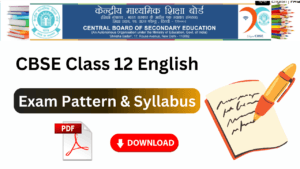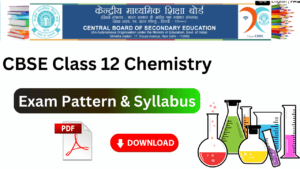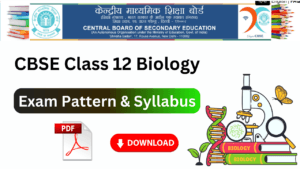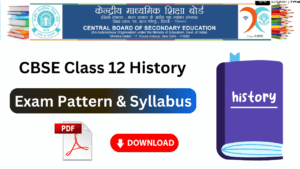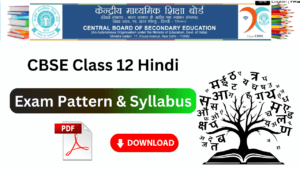Updated CBSE Class 12 Business Studies (BST) Syllabus for 2025-26 – Get the latest chapter-wise syllabus, marking scheme, and study tips. Download the official PDF at the end!
Overview of CBSE Class 12 BST Syllabus 2025-26 The Class 12 CBSE syllabus for BST plays a crucial role in board exams and competitive exams like CUET. This year, CBSE has introduced competency-based questions and a revised weightage system to encourage conceptual learning over rote memorization.
BUSINESS STUDIES (Code No. 054) Class XII (2025-26) Theory: 80 Marks | Time: 3 Hours Project Work: 20 Marks
Course Structure Part A: Principles and Functions of Management (50 Marks) Unit Topic Marks 1 Nature and Significance of Management 16 2 Principles of Management 3 Business Environment 4 Planning 14 5 Organising 6 Staffing 20 7 Directing 8 Controlling Total 50
Part B: Business Finance and Marketing (30 Marks) Unit Topic Marks 9 Financial Management 15 10 Financial Markets 11 Marketing Management 15 12 Consumer Protection Total 30
Part C: Project Work (20 Marks) Detailed Syllabus Unit 1: Nature and Significance of Management Learning Objectives After completing this unit, students will be able to:
Management – Concept, Objectives, and Importance Understand the concept of management. Explain the meaning of effectiveness and efficiency . Discuss the objectives of management. Describe the importance of management. Management as Science, Art, and Profession Examine the nature of management as a science, art, and profession . Levels of Management Understand the roles of top, middle, and lower-level management. Functions of Management Explain the five functions : Planning, Organizing, Staffing, Directing, and Controlling. Coordination – Concept and Importance Discuss the characteristics of coordination . Explain the importance of coordination in management. Unit 2: Principles of Management Learning Objectives Concept & Significance Understand management principles Explain their significance in business Fayol's Principles Discuss 14 principles (Division of Work, Authority, etc.) Taylor's Scientific Management Principles: Science over rule-of-thumb, harmony, cooperation Techniques: Time-study, motion-study, standardization Comparison : Fayol (top-down) vs Taylor (shop-floor focus)Unit 3: Business Environment Learning Objectives Concept & Importance Define business environment Explain its impact on decision-making Dimensions :PESTL Analysis :Economic (GDP, policies) Social (culture, trends) Technological (innovation) Political (stability) Legal (regulations) Demonetization : Concept & featuresUnit 4: Planning Learning Objectives Concept, Importance & Limitations Definition of planning Benefits: Reduces uncertainty Limitations: Rigidity, cost Planning Process Types of Plans Single-use : Budgets, programsStanding : Policies, procedures, methodsUnit 5: Organising Learning Objectives Concept & Importance Organizing as structure (roles) and process (coordination) Organizing Process Organizational Structures Type Pros Cons Functional Specialization Departmental conflicts Divisional Product-focused Resource duplication
Formal vs Informal Formal : Official hierarchyInformal : Social networksDelegation vs Decentralization Aspect Delegation Decentralization Scope Individual tasks Organization-wide Control Superior retains authority Distributed authority
Unit 6: Staffing (20 Marks) Learning Objectives Concept & Importance Definition: Matching jobs with qualified personnel Importance: Ensures organizational efficiency Staffing as HRM Specialized functions: Recruitment, training, performance appraisal Staffing Process graph LR
A[Manpower Planning] --> B[Recruitment]
B --> C[Selection]
C --> D[Training]
D --> E[Performance Evaluation]
Source Advantages Disadvantages Internal Faster, boosts morale Limited pool External Fresh perspectives Costly & time-consuming
Selection Process Training & Development Methods :On-the-job (Apprenticeship, Internship) Off-the-job (Workshops, Vestibule training) Difference : Training (job-specific) vs Development (career growth)Unit 7: Directing Learning Objectives Concept & Importance Directing: Initiating action through instructions Elements of Directing Motivation :Maslow’s Hierarchy: Physiological → Safety → Social → Esteem → Self-actualization Incentives:Financial (Bonuses) Non-financial (Recognition) Leadership Styles :Style Key Trait Authoritative Top-down decisions Democratic Team participation Laissez-faire Minimal supervision
Communication :Types : Formal (official) vs Informal (grapevine)Barriers : Noise, language, perceptionSolutions : Feedback, clarity, active listeningUnit 8: Controlling Learning Objectives Concept & Importance Controlling: Ensuring goals are met Importance: Corrects deviations, improves future planning Planning vs Controlling Relationship :Planning sets goals → Controlling ensures achievement Control Process graph TB
A[Set Standards] --> B[Measure Performance]
B --> C[Compare Results]
C --> D[Take Corrective Action]
Unit 9: Financial Management (15 Marks) Learning Objectives Concept & Objectives Definition: Efficient allocation of financial resources Objectives: Wealth maximization, profit maximization Financial Decisions Decision Type Key Factors Investment ROI, Risk Financing Cost, Risk Dividend Liquidity, Growth needs
Financial Planning Importance: Ensures fund availability, reduces uncertainty Capital Structure Factors: Cost of capital, risk, control considerations Fixed vs Working Capital Type Determinants Fixed Capital Nature of business, scale Working Capital Operating cycle, credit terms
Unit 10: Financial Markets Learning Objectives Financial Markets Overview Money Market : Short-term funds (<1 year)Capital Market : Long-term fundsCapital Market Types graph LR
A[Capital Market] --> B[Primary Market]
A --> C[Secondary Market]
Stock Exchange Functions: Liquidity, price discovery Trading Procedure: Order → Execution → Settlement → Demat transfer SEBI Objectives: Investor protection, market regulation Functions:Regulatory (Registration of brokers) Developmental (Promoting transparency) Unit 11: Marketing Management (15 Marks) Learning Objectives Marketing Concepts Philosophies: Production → Product → Selling → Marketing → Societal Marketing Mix (4Ps) Element Key Aspects Product Branding, Packaging Price Cost, Competition Place Distribution channels Promotion Advertising, PR
Product Strategies Branding : Creates identityPackaging : Protection & promotionDistribution Channels graph TB
Manufacturer --> Wholesaler --> Retailer --> Consumer
Promotion Mix Advertising : Mass communicationSales Promotion : Short-term incentivesPublic Relations : Building goodwillUnit 12: Consumer Protection Learning Objectives By the end of this unit, students will be able to:
Concept & Importance Define consumer protection Explain its importance: Consumer Protection Act, 2019 Key Features :Covers goods & services (including e-commerce) Establishes Central Consumer Protection Authority (CCPA) Who is a Consumer? Any person who: Consumer Rights & Responsibilities Rights Responsibilities Right to safety Be quality-conscious Right to information Read labels carefully Right to choose Assert rights responsibly Right to be heard Avoid wasteful consumption
graph LR
A[District Commission] --> B[State Commission] --> C[National Commission]
Timeframe :Remedies Available Replacement/refund Compensation (up to ₹1 crore) Discontinuation of unfair practices Role of Consumer Organizations & NGOs Functions :Key Case Studies Landmark Judgments :MC Mehta vs Union India (1986): Expanded 'right to life' to include pollution-free environmentAmbrish Shukla vs Ferrous Infrastructure (2016): Compensation for delayed housing projectRecent Initiatives :Jago Grahak Jago campaignNational Consumer Helpline (1915)Download CBSE Class 12 BST Syllabus 2025-26 PDF Click the button below to download the official CBSE syllabus PDF for 2025-26.
📂 Download CBSE Class 12 BST Syllabus PDF
Related Guides CBSE Class 12 Syllabus – All Subjects
Stay Updated! Join our Telegram/WhatsApp group for CBSE updates, free notes, and exam tips!
Bookmark this page & keep revising smartly!

